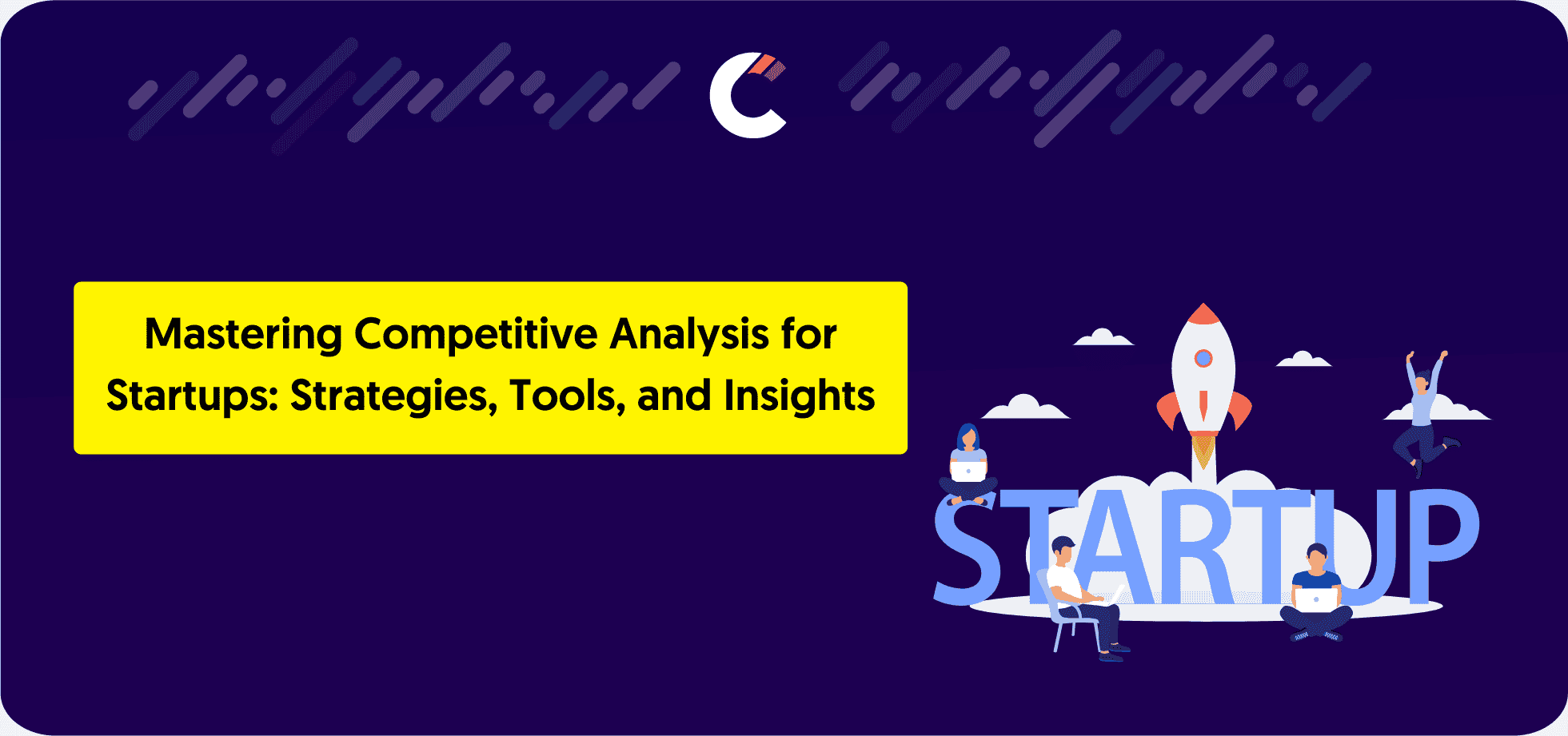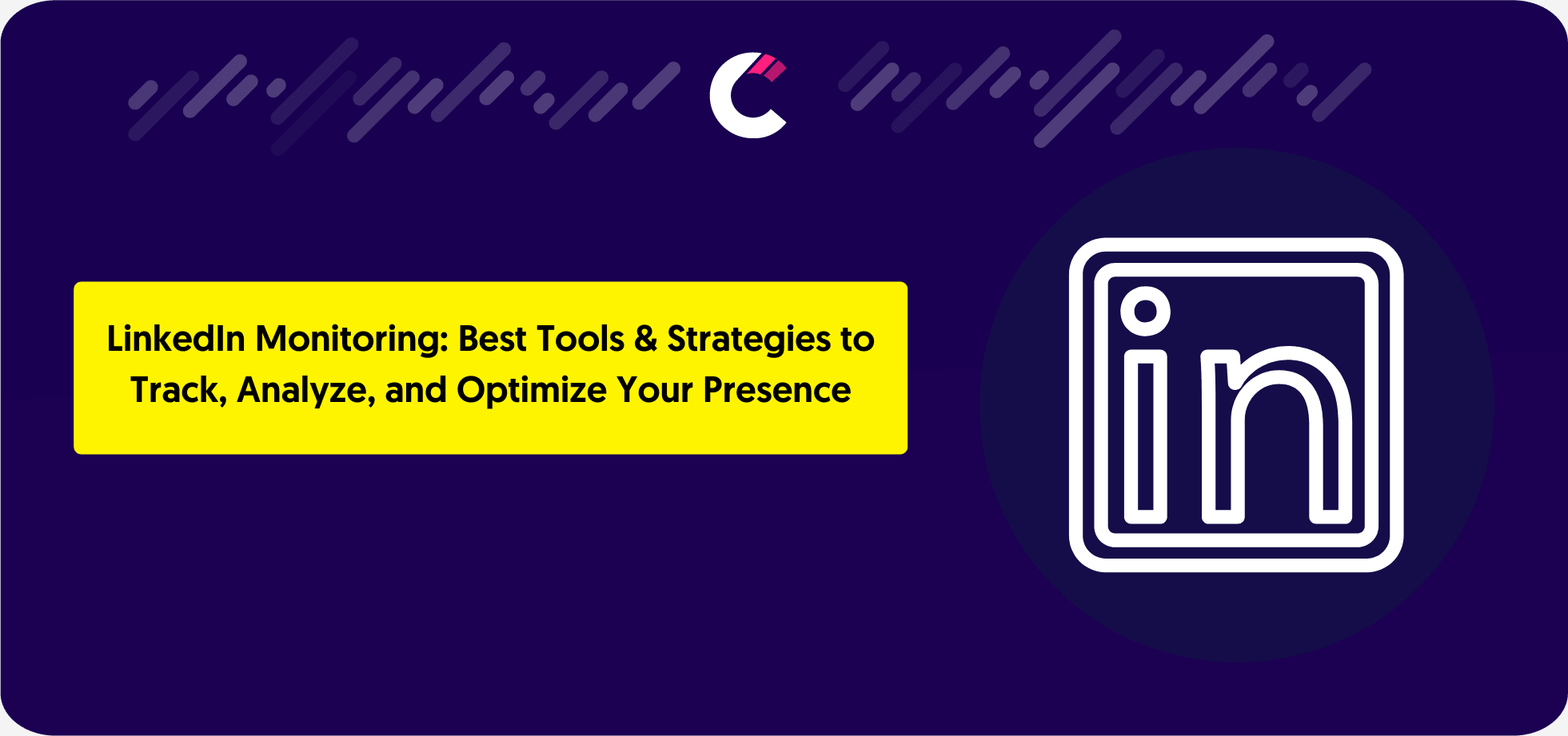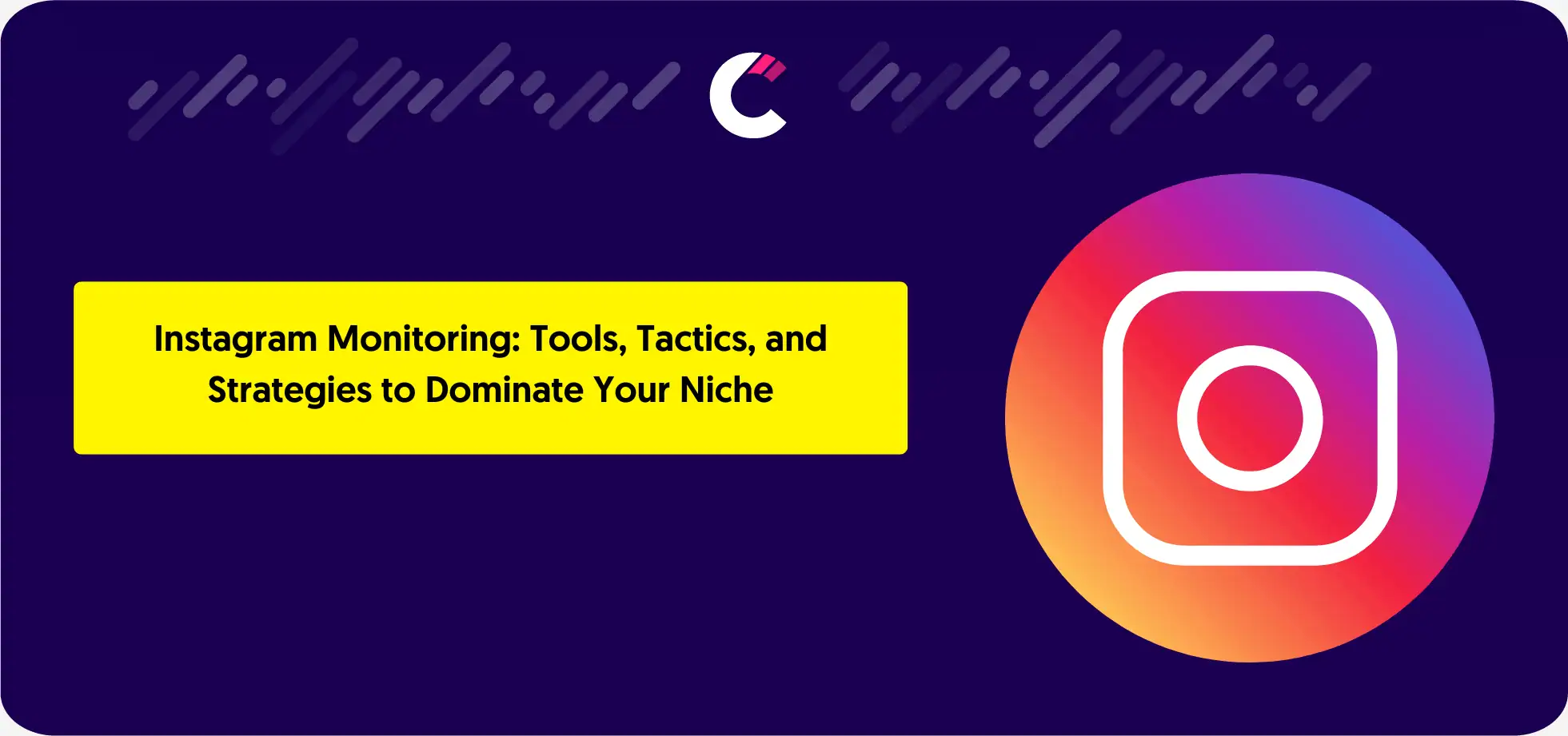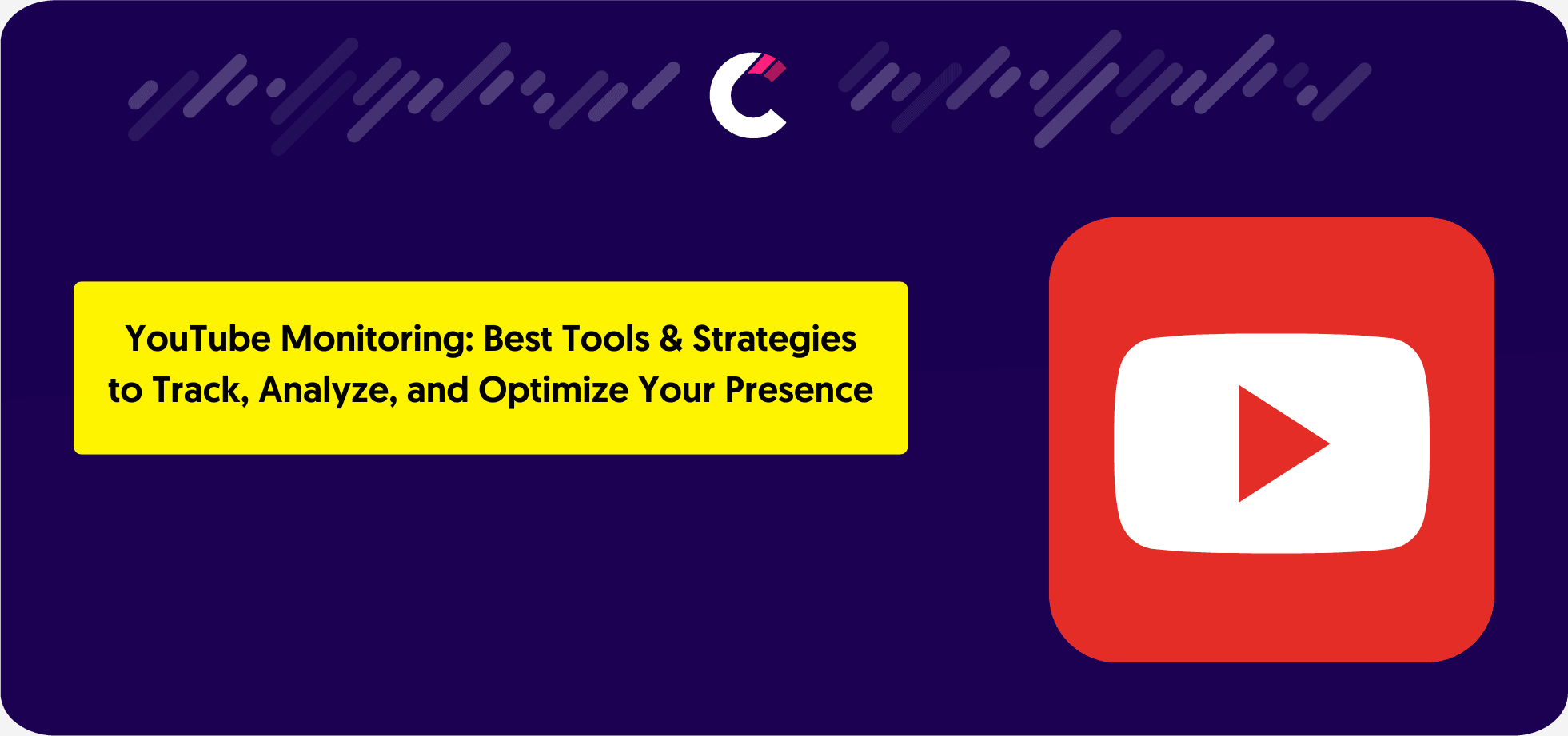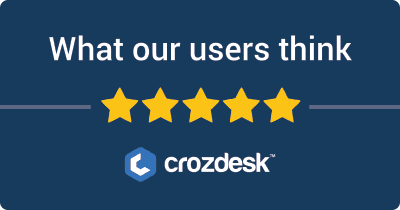For startups, every decision can be the difference between standing out or blending in. To outpace the competition, understanding what others in your space are doing isn’t optional—it’s essential.
Competitive analysis for startups goes beyond observing trends; it’s about uncovering opportunities to refine your approach, improve your offerings, and connect better with your audience.
Whether it’s identifying gaps in your competitors’ strategies or discovering untapped market potential, this guide will walk you through mastering the art of startups competitors analysis. Let’s get started.
Why Competitive Analysis is Crucial for Startups
Startups often operate in high-stakes environments, where every move matters. Competitive analysis equips founders and teams with the insights needed to navigate these challenges effectively. By analyzing competitors’ strategies and market positioning, startups can refine their own approach to stand out. The benefits are tangible:
- Improved market positioning: Understanding competitors helps startups identify unique selling points and better position their products or services.
- Better decision-making: Clear insights into what works (or doesn’t) in the industry lead to informed, data-driven choices.
- Targeted customer acquisition: Competitive analysis reveals what attracts your ideal customers, helping you tailor your marketing and offerings accordingly.
For startups aiming to grow strategically, competitors analysis is a tool for turning observations into actionable opportunities.
Identifying Your Startup’s Competitors
Before diving into analysis, it’s crucial to define who your competitors are. Not all competitors are created equal, and understanding their types ensures a focused approach to your strategy.
Who Are Your Competitors?
- Direct competitors: These are businesses offering similar products or services and targeting the same customer base.
- Indirect competitors: They address the same customer needs but with different solutions. For example, a rideshare app and a public transit system.
- Potential future competitors: Emerging startups or companies planning to enter your space soon.
Methods to Find Competitors:
- Conduct keyword research: Search for industry-specific terms to identify active players. Tools like Google Search can provide an overview of who’s ranking and why.
- Explore LinkedIn: Many businesses showcase their offerings here, making it a goldmine for identifying competitors.
- Track online activities: Use specialized tools to monitor competitors’ websites, ad campaigns, and content updates.
- Use Competitor Finder: Use our free AI tool to find your competitors. Simply add a keyword or two that are relevant to your industry and your website URL and our tool will find you a list of your top competitors in seconds!
Talk to Potential Customers:
Engage with your target audience to learn about the alternatives they’re already considering. This direct feedback often uncovers competitors you might have overlooked.
Be a Consumer Yourself:
Experience your competitors’ offerings firsthand. From signing up for their services to purchasing their products, this approach provides an inside look at their strengths, weaknesses, and overall strategy.
How to Conduct a Competitive Analysis for Startups using Competitors App

Step 1: Define Your Competitors
Use the Competitors App Competitor Finder to identify who you're up against in the market.
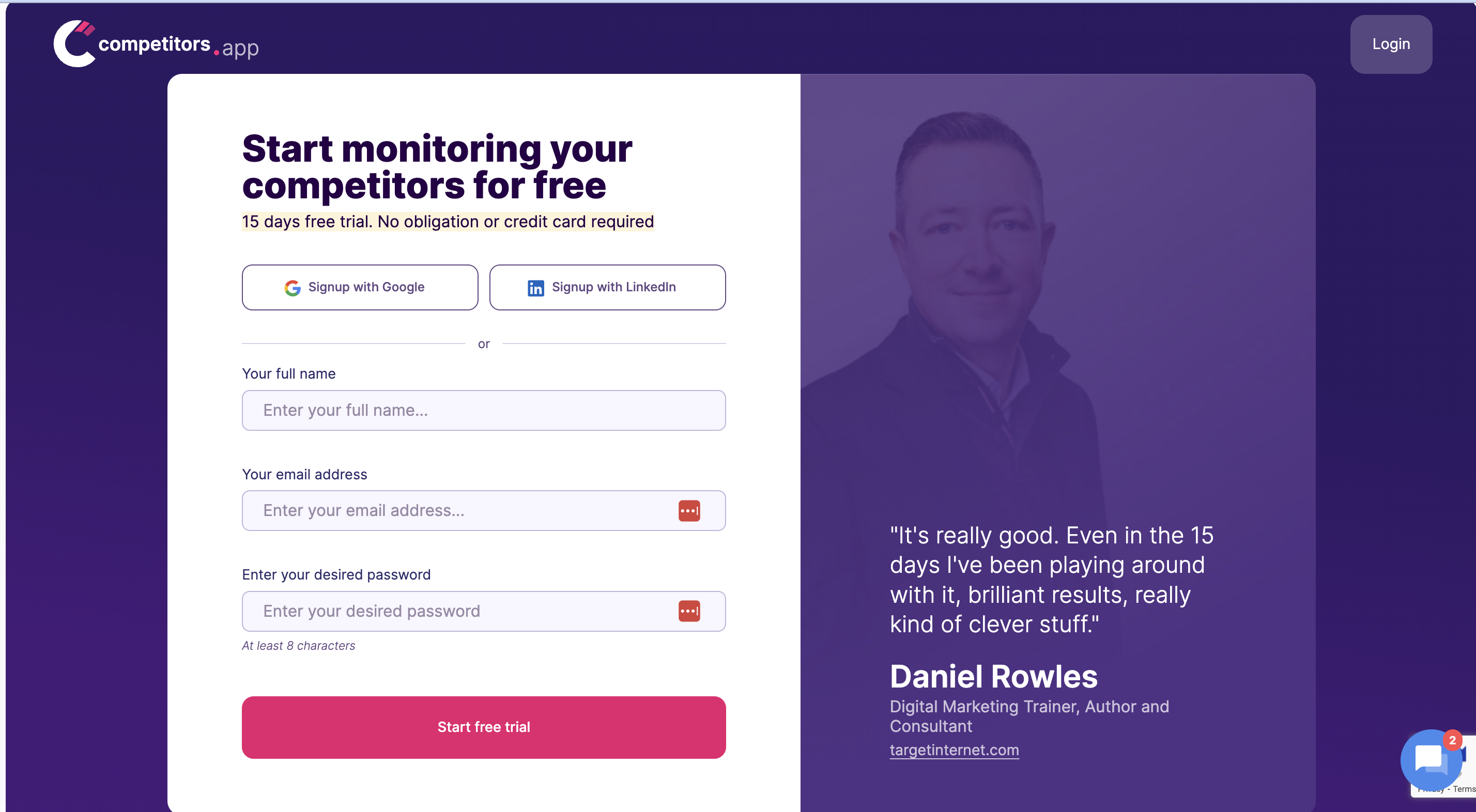
Step 2: Get Started with a Free Trial
Sign up for a Competitors App Free trial account to unlock a wealth of features designed to give you an edge.
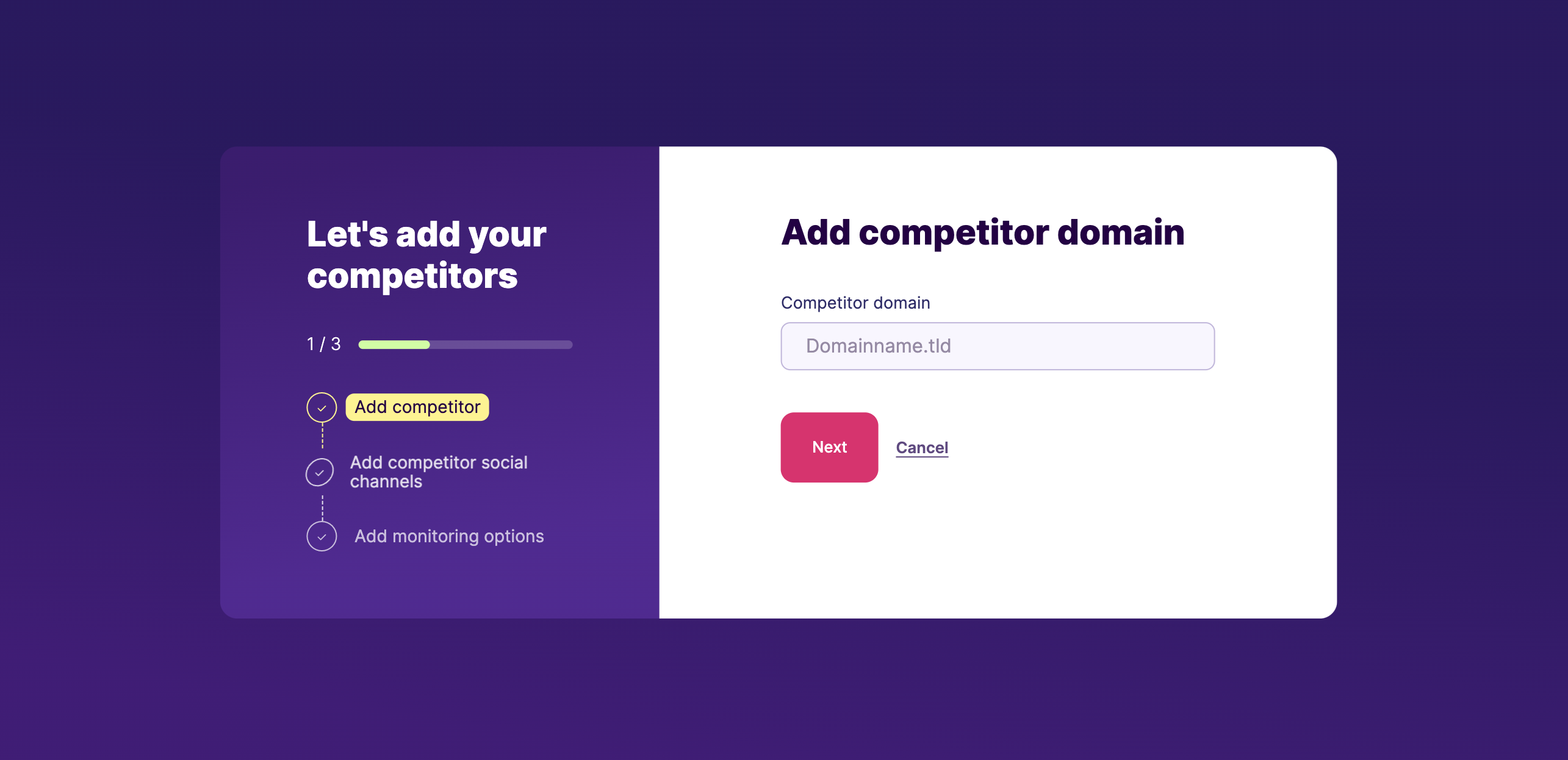
Step 3: Add Your Competitors
Add your competitor domain on the field. Competitors app will automatically detect their social media, most important website pages, and reviews
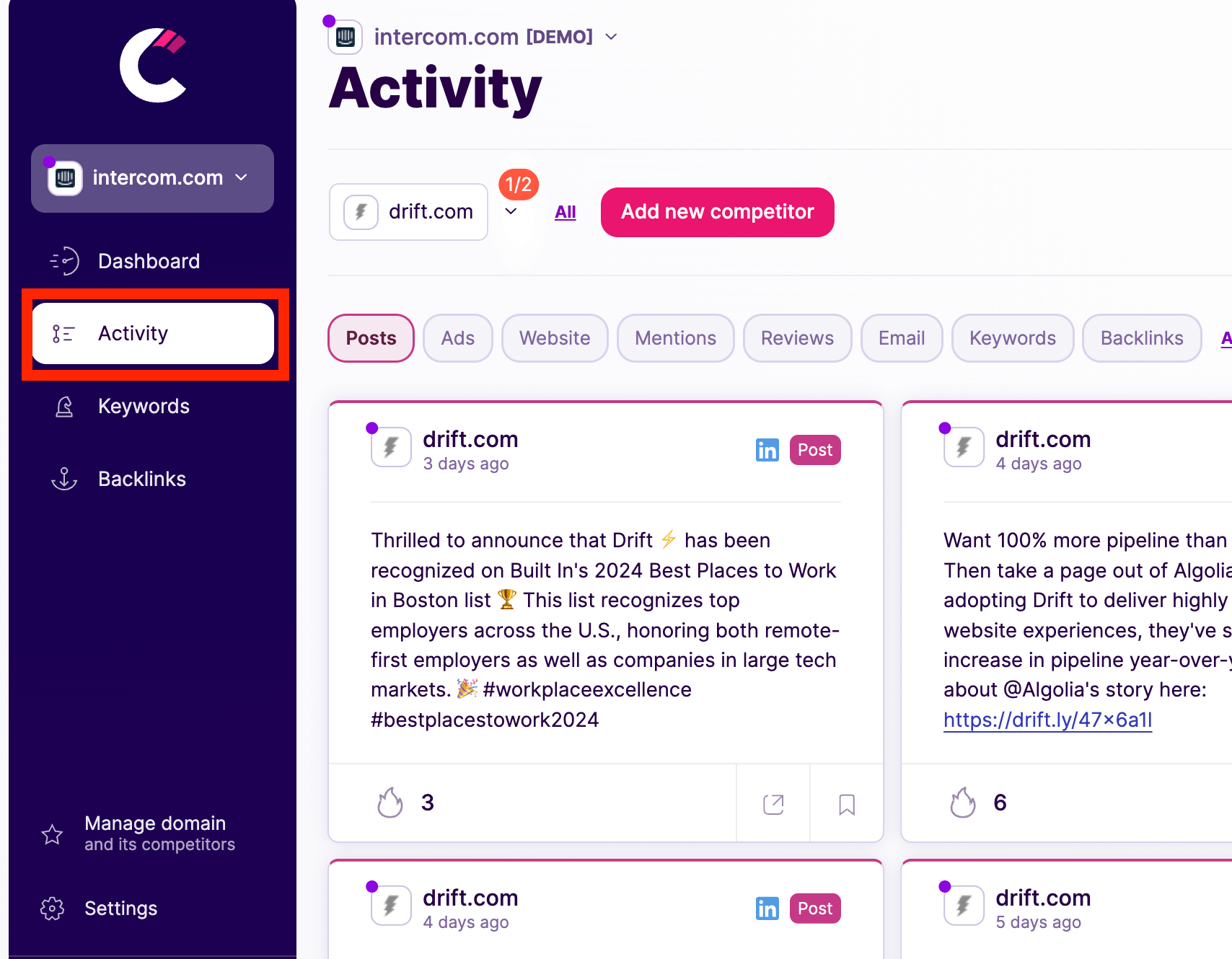
Step 4: Review New and Historical Activity
Start diving into the historical activity of your competitors. This will give you a clearer picture of their past strategies and performance metrics. At the same time keep an eye for new updates.
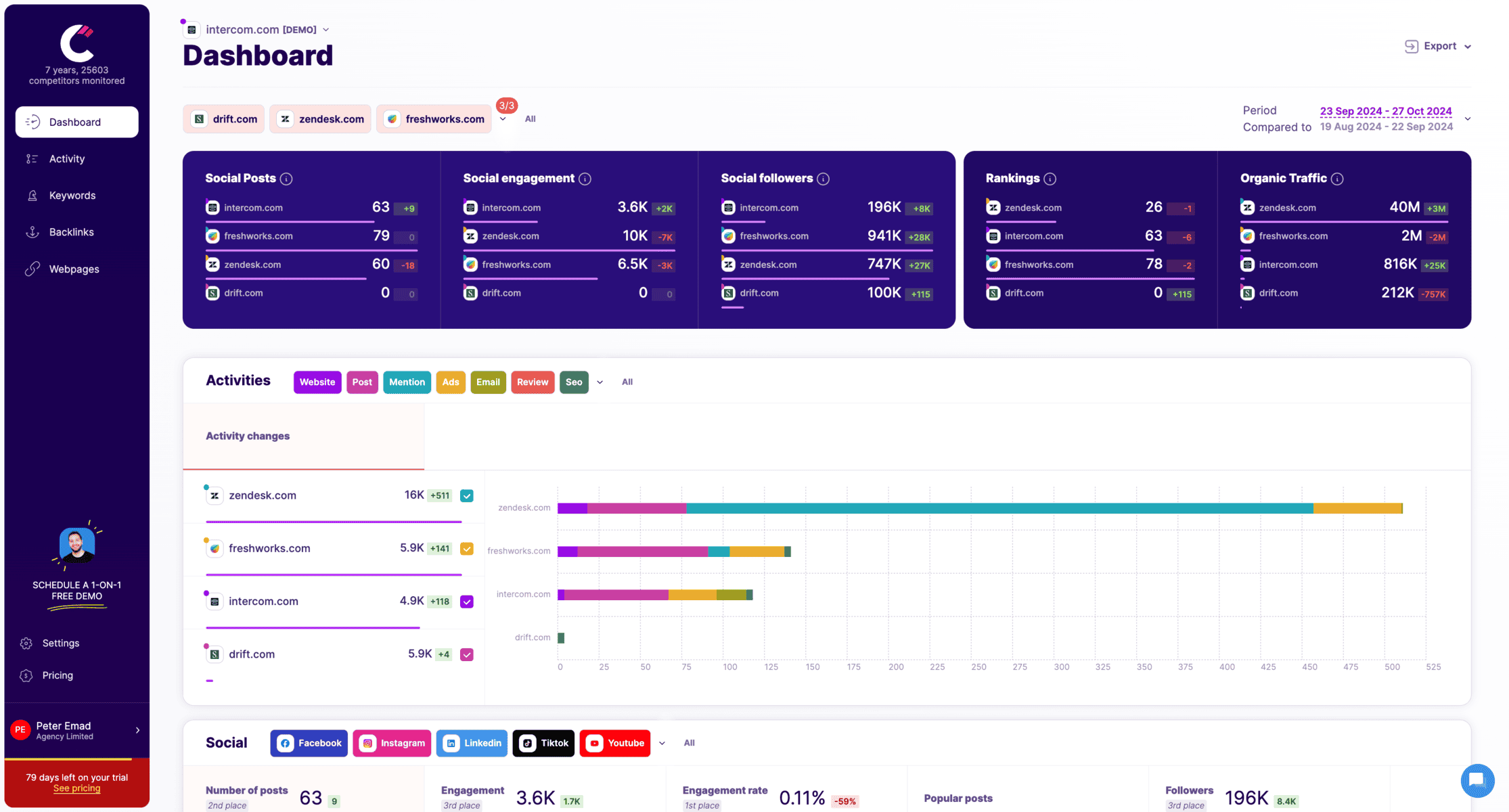
Step 5: Benchmark Yourself
Use Competitors App Dashboard and the data you've collected to benchmark your company against the competition. This will help you identify your strengths and weaknesses in the market.
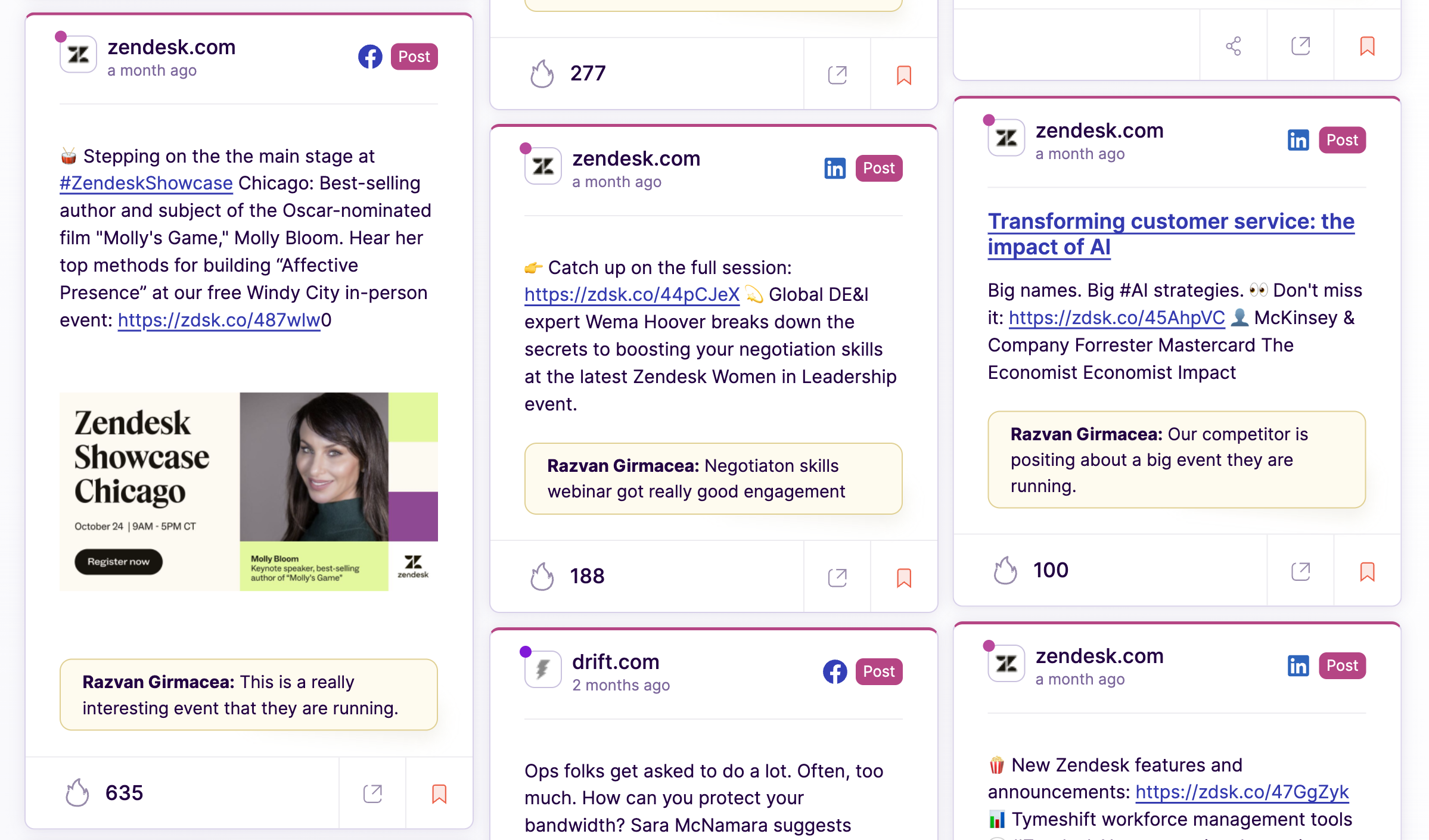
Step 6: Save insights and add notes to collect and explain the best competitor strategies
Finally, utilize one of our competitor analysis templates to compile all your findings into a comprehensive report. Share this with your team. It's important to add actionable tips at the end of the page.
Competitors App Features
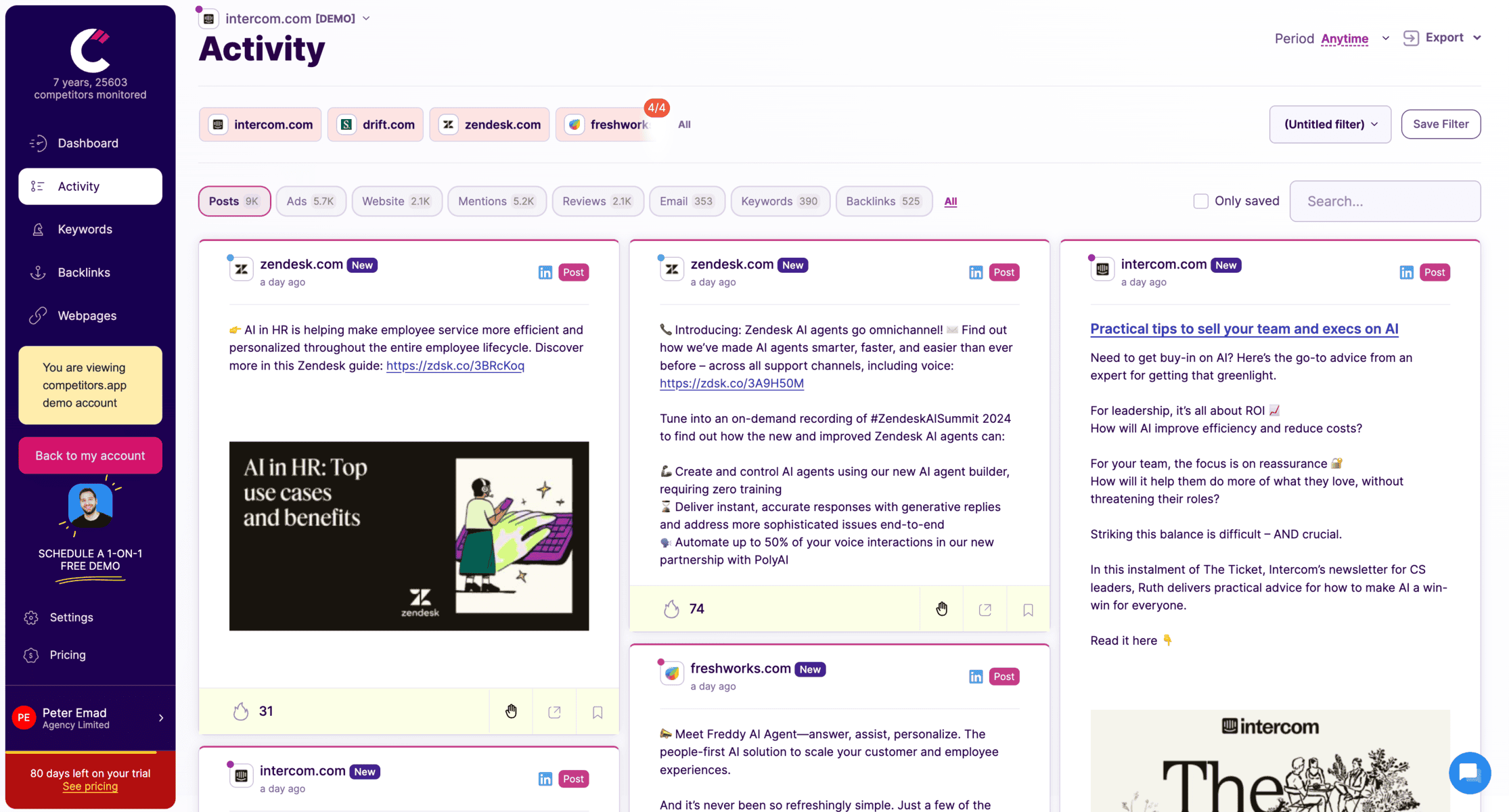
Tracks competitor social media updates across LinkedIn, Facebook, Twitter, and more.
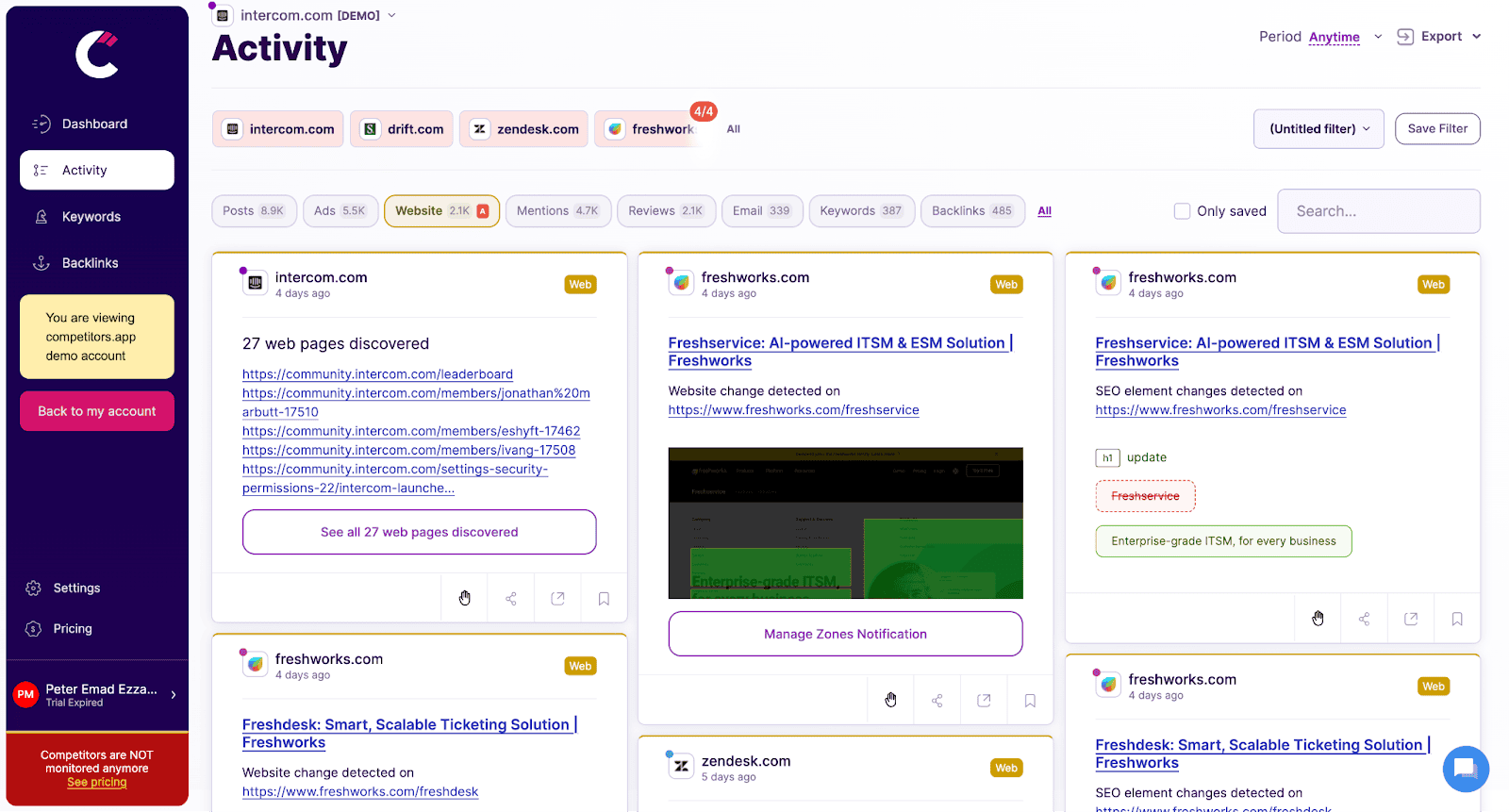
Monitors changes on competitors’ websites, such as product updates, pricing adjustments, and new messaging, providing instant alerts to help sales teams respond promptly.
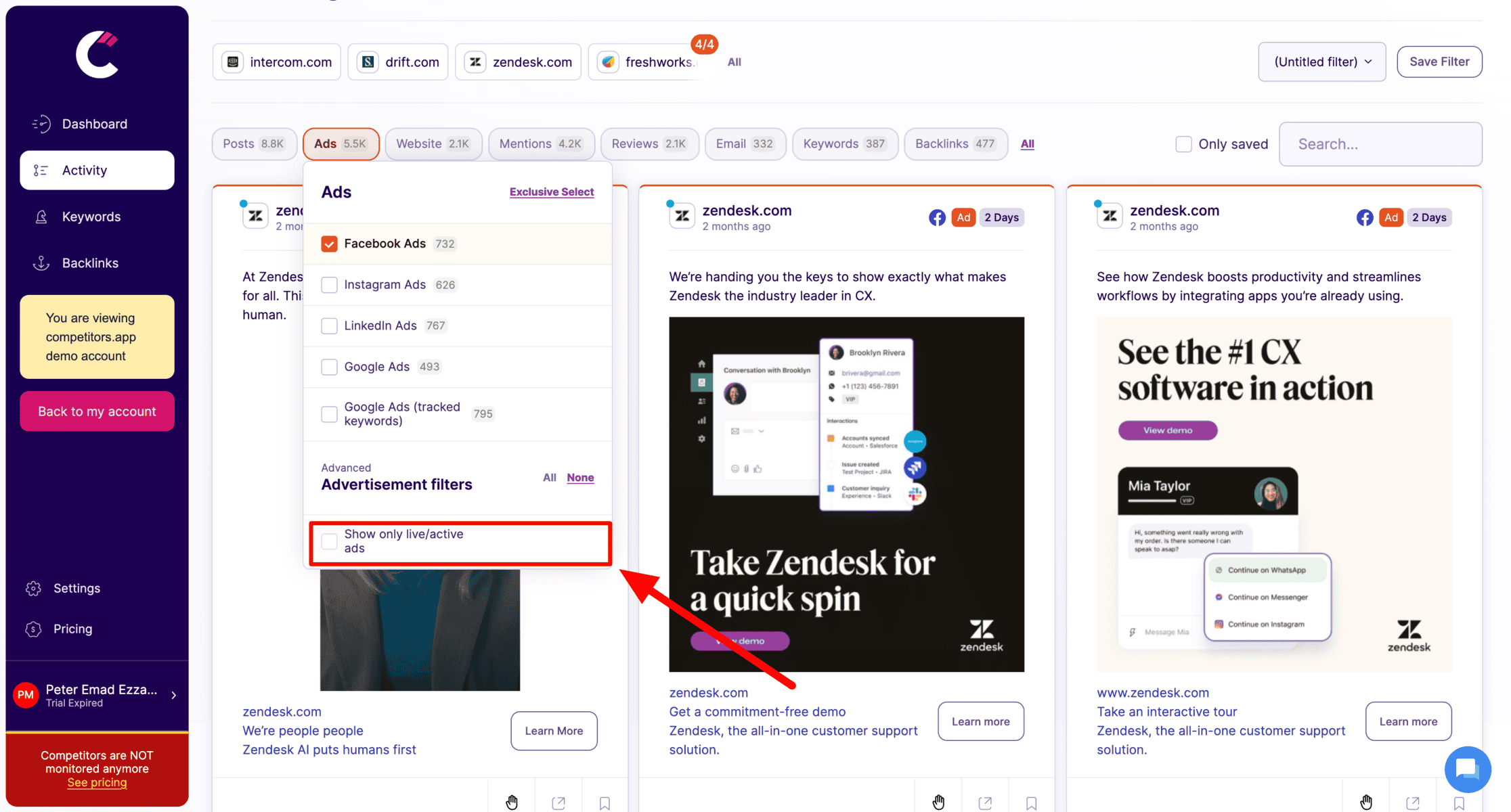
Tracks digital ad campaigns across platforms like Google Ads, Facebook, LinkedIn, and Instagram. It provides details on ad creatives, spending, and performance metrics, helping teams analyze successful ad strategies.

Analyzes competitors’ keyword strategies, organic rankings, and backlinks, allowing teams to refine their own SEO tactics and boost search visibility.
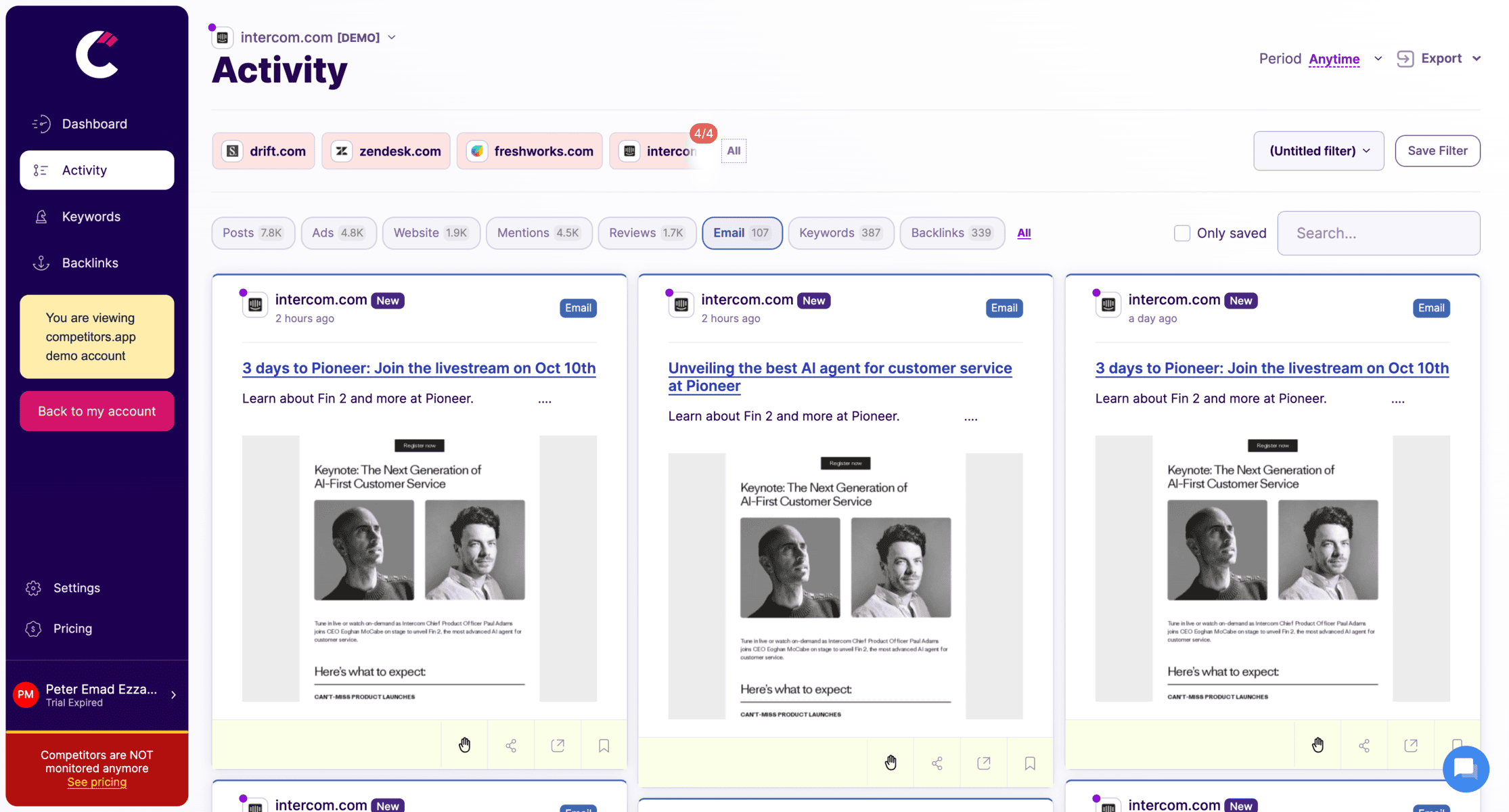
Tracks competitors’ email campaigns, including content, frequency, and engagement metrics, helping sales teams understand email tactics that drive engagement and conversions.
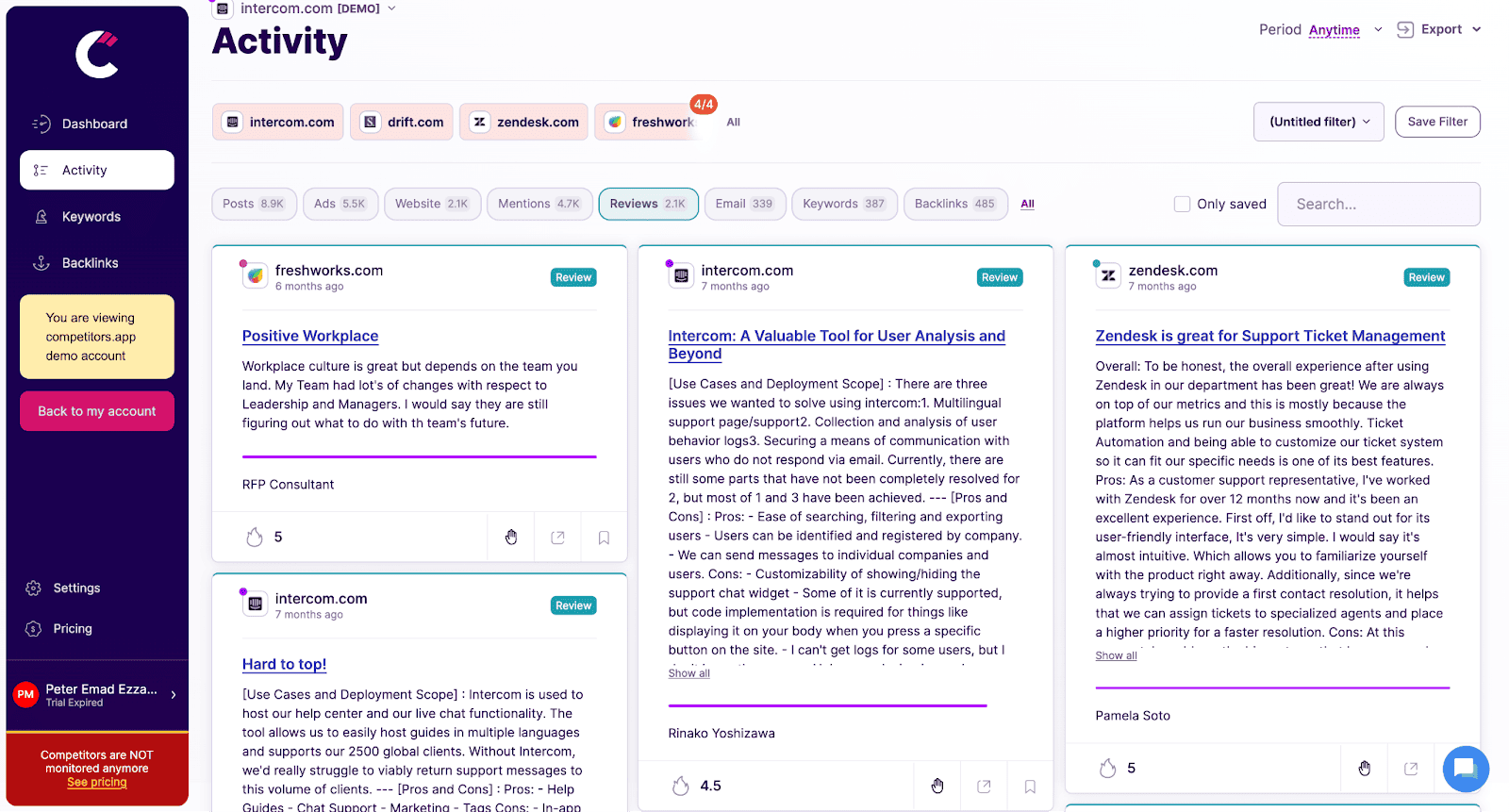
Analyzes customer reviews and ratings for competitors, providing insights into customer feedback, pain points, and product strengths, helping teams craft better sales pitches.
Where to Find Information About Competitors
Accessing the right information about competitors is essential for effective analysis. The good news is that startups can leverage numerous sources to gather actionable insights.
Utilize Online Tools and Platforms
Digital tools streamline the process of tracking competitors. Platforms like SEMrush, Ahrefs, and Google Alerts allow you to monitor their SEO strategies, website updates, and online visibility. These tools provide a detailed view of what your competitors are doing to capture market attention.
Analyze Publicly Available Data
Blogs, press releases, and news articles often reveal valuable insights about competitors. For example, a press release might highlight a new product launch or expansion plans. Regularly reviewing these sources ensures you stay updated on their latest activities.
Engage with Customer Reviews and Forums
Customer feedback platforms such as Trustpilot, G2, and Reddit can uncover recurring themes in competitor reviews. Positive feedback sheds light on what they’re excelling at, while negative reviews reveal potential gaps or pain points you can address.
Explore Social Media and Advertising Channels
Competitors’ social media profiles are treasure troves of information. Analyze their engagement strategies, popular content formats, and ad campaigns. Platforms like Facebook Ad Library let you see their active advertisements, helping you understand their promotional focus.
Using Competitor Analysis Findings for Startup Success
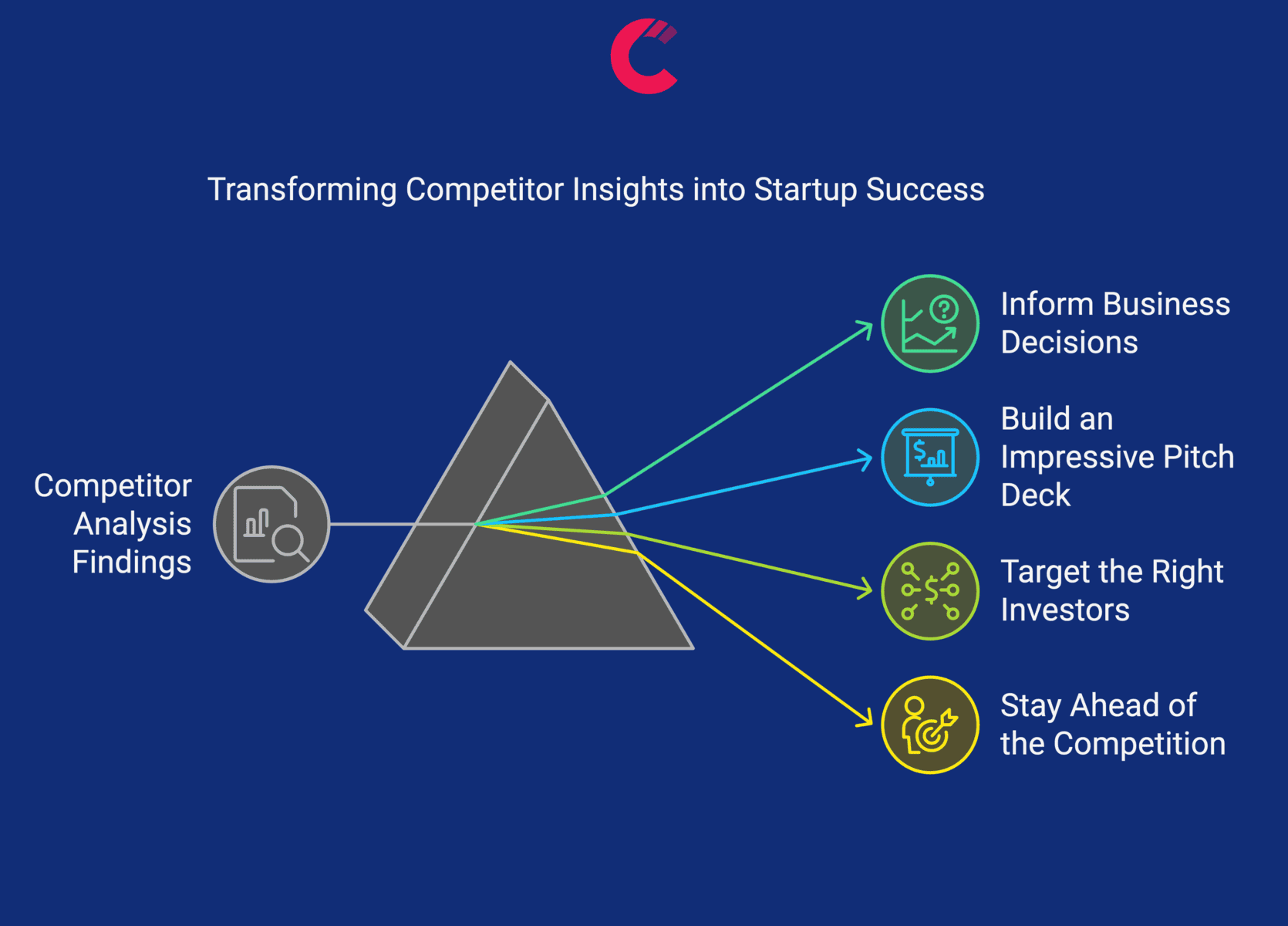
Collecting competitor insights is only half the battle; the real advantage comes from transforming this information into actionable strategies that drive your startup’s growth.
Here’s how you can turn analysis into meaningful results:
Inform Business Decisions
Competitor analysis equips startups with the context needed to refine their strategies. For example, if a competitor’s recent success stems from a new pricing model or product feature, you can assess its viability for your business. Similarly, understanding which marketing channels generate the most engagement for competitors can help you focus your efforts and budget effectively. Every decision, from product development to customer service enhancements, can benefit from competitor-driven insights.
Build an Impressive Pitch Deck
When presenting your startup to potential investors, showcasing your understanding of the competitive landscape adds credibility. Include data on market gaps, competitor weaknesses, and your unique positioning. For instance, if competitors struggle with customer retention due to limited product features, highlighting how your offering addresses this challenge shows investors why your startup is a valuable bet. A well-researched competitor analysis section demonstrates that you’ve done your homework and understand the market dynamics.
Target the Right Investors
Not all investors are a fit for your startup, and competitor analysis can help narrow your focus. Identify investors who have funded similar businesses or who specialize in your industry. For example, if your analysis reveals a gap in sustainability-focused offerings, targeting investors with a track record of supporting green businesses could be more fruitful. Customizing your approach increases your chances of securing aligned partnerships.
Stay Ahead of the Competition
Competitor analysis is not a one-time activity; it’s an ongoing process that evolves with the market. By continuously monitoring competitors’ product launches, marketing campaigns, and customer feedback, you can identify emerging trends and adapt proactively. For example, if a competitor launches a feature that gains traction, you can quickly evaluate its relevance and innovate further to differentiate your offering. Regular analysis keeps you agile and prepared for market shifts.
Challenges and Limitations of Competitive Analysis
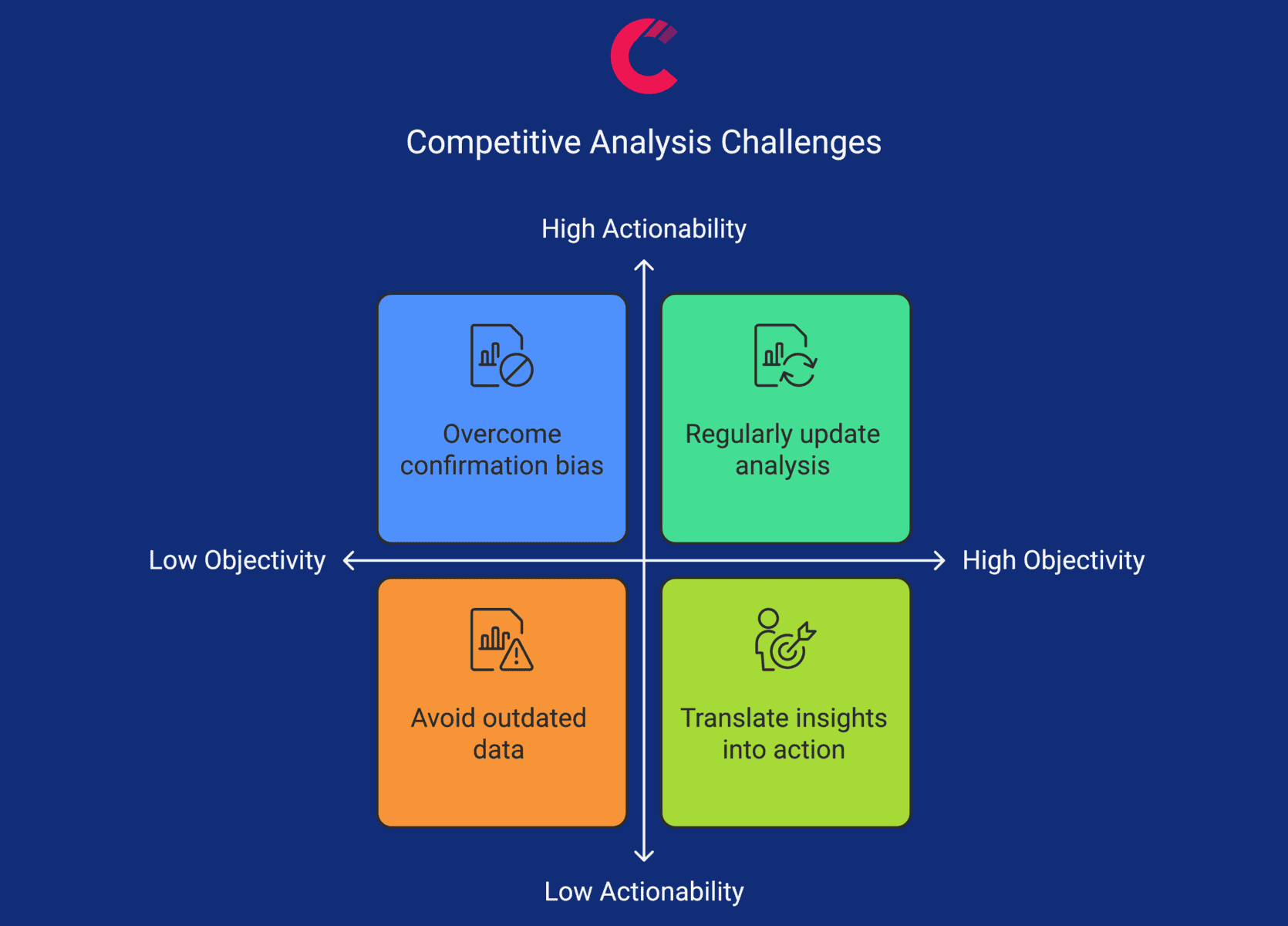
While competitive analysis is a powerful tool, it’s not without its challenges. Startups must approach the process with a clear understanding of its limitations to avoid common pitfalls and maximize its effectiveness.
Beware of Confirmation Bias
One of the biggest risks in competitive analysis is interpreting data to confirm pre-existing beliefs. For example, if a startup assumes a competitor’s success is solely due to pricing, they might overlook other crucial factors like superior customer service or brand loyalty. Staying objective and letting the data guide your conclusions is essential for accurate analysis.
Take Action on Findings
Collecting data is only valuable if it leads to action. A common mistake is spending excessive time on research without translating insights into tangible improvements. For instance, if your analysis highlights a competitor’s success with influencer marketing, use that insight to experiment with similar campaigns tailored to your audience. Insights should serve as a catalyst for informed decisions.
Keep Your Analysis Updated
The market doesn’t stand still, and neither should your analysis. Relying on outdated competitor data can lead to misinformed strategies. For example, a competitor who once focused solely on budget-conscious customers may now be targeting premium segments. Revisiting your analysis regularly—ideally every quarter—ensures your strategies remain relevant and competitive.
Limited Access to Internal Data
Competitive analysis often relies on publicly available information, which can provide an incomplete picture. Internal metrics such as conversion rates, profit margins, and churn rates are typically inaccessible. While this limitation is unavoidable, focusing on the data you can access—like website traffic, reviews, and visible marketing tactics—can still yield actionable insights.
By acknowledging these challenges and addressing them strategically, startups can ensure that their competitive analysis remains accurate, actionable, and impactful.
What is competitive analysis, and why is it important for startups?
Competitive analysis involves studying your competitors’ strategies, products, and market positioning to identify opportunities and threats. For startups, it’s a crucial process that helps refine strategies, improve market positioning, and make data-driven decisions, ensuring a stronger footing in competitive markets.
How do I identify my startup competitors?
Start by categorizing competitors into direct (offering similar products), indirect (serving the same need differently), and potential future competitors (new entrants). Tools like LinkedIn, Google Search, and platforms for monitoring competitors’ online activities can help identify them. Engaging with potential customers can also uncover competitors you may not have considered.
What tools can I use for digital competitor analysis?
Several tools can simplify the process and provide actionable insights:
- Competitors App: Ideal for tracking competitors’ website updates, ad campaigns, content strategies, and social media activities in real time. This tool is particularly useful for startups seeking a comprehensive view of digital activities.
- SEMrush: Offers detailed insights into SEO performance and website traffic.
- Google Alerts: Tracks mentions of competitors in news and online updates, keeping you informed of their activities.
- Ahrefs: Focuses on backlink analysis, keyword research, and content gaps.
Using these tools allows startups to analyze competitors’ strategies effectively and stay ahead in the game.
How often should I conduct a competitive analysis?
Ideally, startups should update their competitive analysis quarterly or whenever significant market changes occur, such as a new competitor entering the market or a major product launch by an existing player. Regular updates ensure your strategies remain relevant.
How can startups benefit from using competitor analysis?
Competitor analysis helps startups identify gaps in the market, refine pricing and product strategies, and create marketing campaigns that resonate with their target audience. By keeping an eye on competitors, startups can proactively adapt to trends and seize opportunities faster.
What are some common mistakes in competitive analysis?
- Confirmation bias: Focusing only on data that supports pre-existing beliefs.
- Neglecting actionable outcomes: Failing to act on the insights gathered.
- Relying on outdated information: Overlooking market shifts due to infrequent updates.
Avoiding these pitfalls ensures your analysis remains effective.
Can I use competitor analysis data to attract investors?
Yes, including competitor analysis in your pitch deck shows investors that you understand the market landscape and have a strategic plan to stand out. Highlighting data-driven insights about gaps in competitors’ offerings and your approach to addressing them adds credibility to your business case.
